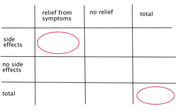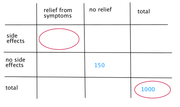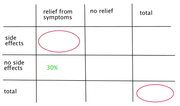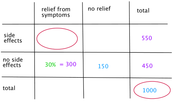Source: Official Guide
In a product test of a common cold remedy, x percent of the patients tested experienced side effects from the use of the drug and y percent experienced relief of cold symptoms. What percent of the patients tested experienced both side effects and relief of cold symptoms?
(1) Of the 1,000 patients tested, 15 percent experienced neither side effects nor relief of cold symptoms.
(2) Of the patients tested, 30 percent experienced relief of cold symptoms without side effects.
The OA is E.
In a product test of a common cold remedy, x percent of the
This topic has expert replies
-
BTGmoderatorLU
- Moderator
- Posts: 2218
- Joined: Sun Oct 15, 2017 1:50 pm
- Followed by:6 members
Timer
00:00
Your Answer
A
B
C
D
E
Global Stats
GMAT/MBA Expert
- Jay@ManhattanReview
- GMAT Instructor
- Posts: 3008
- Joined: Mon Aug 22, 2016 6:19 am
- Location: Grand Central / New York
- Thanked: 470 times
- Followed by:34 members
Timer
00:00
Your Answer
A
B
C
D
E
Global Stats
Say,BTGmoderatorLU wrote:Source: Official Guide
In a product test of a common cold remedy, x percent of the patients tested experienced side effects from the use of the drug and y percent experienced relief of cold symptoms. What percent of the patients tested experienced both side effects and relief of cold symptoms?
(1) Of the 1,000 patients tested, 15 percent experienced neither side effects nor relief of cold symptoms.
(2) Of the patients tested, 30 percent experienced relief of cold symptoms without side effects.
The OA is E.
the number of patients who experienced ONLY side effects = S;
the number of patients who experienced ONLY relief of cold symptoms = C;
the number of patients who experienced BOTH side effects & relief of cold symptoms = B;
the number of patients who experienced NEITHER side effects NOR relief of cold symptoms = N
We have to get the value of B.
Let's take each statement one by one.
(1) Of the 1,000 patients tested, 15 percent experienced neither side effects nor relief of cold symptoms.
=> N = 15% of 1000 = 150.
Can't get the value of B. Insufficient.
(2) Of the patients tested, 30 percent experienced relief of cold symptoms without side effects.
=> C = 30% of 1000 = 300.
Can't get the value of B. Insufficient.
(1) and (2) together
We have N = 150 and C = 300.
However, we can't get the value of B. Insufficient.
The correct answer: E
Hope this helps!
-Jay
_________________
Manhattan Review
Locations: Manhattan Review Jayanagar | GMAT Prep Tarnaka | GRE Prep Madhapur | Kukatpally GRE Coaching | and many more...
Schedule your free consultation with an experienced GMAT Prep Advisor! Click here.
GMAT/MBA Expert
- ceilidh.erickson
- GMAT Instructor
- Posts: 2095
- Joined: Tue Dec 04, 2012 3:22 pm
- Thanked: 1443 times
- Followed by:247 members
Timer
00:00
Your Answer
A
B
C
D
E
Global Stats
One easy way to organize overlapping sets questions is with a Double Set Matrix:BTGmoderatorLU wrote:Source: Official Guide
In a product test of a common cold remedy, x percent of the patients tested experienced side effects from the use of the drug and y percent experienced relief of cold symptoms. What percent of the patients tested experienced both side effects and relief of cold symptoms?
(1) Of the 1,000 patients tested, 15 percent experienced neither side effects nor relief of cold symptoms.
(2) Of the patients tested, 30 percent experienced relief of cold symptoms without side effects.
The OA is E.

We're looking for those who experienced both as a percent of the total:

Now let's look at the statements individually:
(1) Of the 1,000 patients tested, 15 percent experienced neither side effects nor relief of cold symptoms.
We can add a total value and a value to the "neither" box:

This doesn't give any information about "both," though. Insufficient.
Make sure to erase what we knew from statement 1 before adding statement 2 info!
(2) Of the patients tested, 30 percent experienced relief of cold symptoms without side effects.
We have a percentage in this box:

.. but this doesn't give us anything about the "both" box.
Now put them together:

We can get values for the total with side effects and without, but we can't infer anything about how many have both. Insufficient.
The answer is E.
---------------------------------------------------------------
Double Set Matrixes are very useful for this sort of problem! For more practice on those, see:
https://www.beatthegmat.com/retailers-q ... tml#809549
https://www.beatthegmat.com/in-a-class- ... tml#802582
https://www.beatthegmat.com/jefferson-s ... tml#708717
https://www.beatthegmat.com/sandwich-t2 ... tml#730500
https://www.beatthegmat.com/ds-question ... tml#677080
https://www.beatthegmat.com/survery-res ... tml#576105
https://www.beatthegmat.com/rainbow-tro ... tml#555603
Ceilidh Erickson
EdM in Mind, Brain, and Education
Harvard Graduate School of Education
EdM in Mind, Brain, and Education
Harvard Graduate School of Education



















